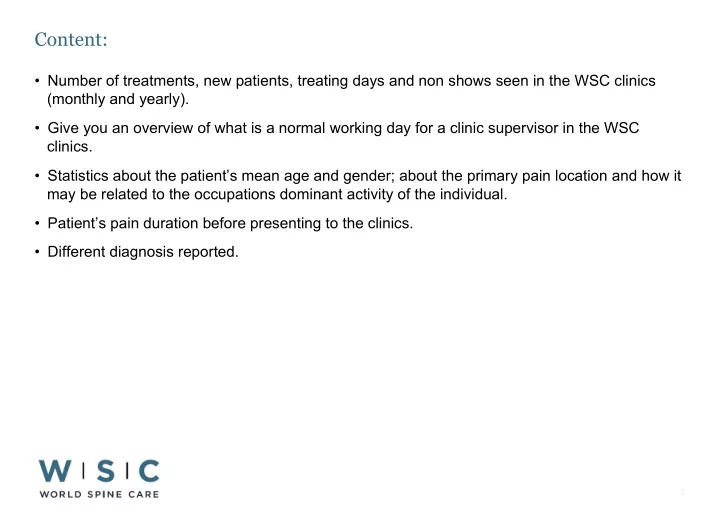

Content: • Number of treatments, new patients, treating days and non shows seen in the WSC clinics (monthly and yearly). • Give you an overview of what is a normal working day for a clinic supervisor in the WSC clinics. • Statistics about the patient’s mean age and gender; about the primary pain location and how it may be related to the occupations dominant activity of the individual. • Patient’s pain duration before presenting to the clinics. • Different diagnosis reported. 1 1
Clinic monthly statistics Clinic location (Shoshong- #s Clinic location #s Total March 2016) (Mahalapye March- 2016 2016) Treatments 29 Treatments 71 100 New Patients 3 New Patients 7 10 Number of treating days 4 Number of treating 10 14 days No shows 13 No shows 23 36 Cumulative Clinic statistics Clinic location (Shoshong- #s Clinic location #s Total 2016) (Mahalapye 2016). 2016 Treatments 135 Treatments 201 336 New Patients 17 New Patients 36 53 Number of treating days 16 Number of treating 27 43 days No shows 52 No shows 53 105 2 2
Cumulative Clinic statistics Clinic location (Shoshong- #s Clinic location #s Total 2015) (Mahalapye 2015). 2015 Treatments 1587 Treatments 1632 3219 New Patients 112 New Patients 144 256 Number of treating days 102 Number of treating 96 198 days No shows 626 No shows 676 1302 Year. NP Treatments No shows Days Mahalapye 2011 7 4 1 4 2012 185 1149 271 126 2013 130 1301 369 87 2014 195 1546 588 97 Year. NP Treatments No shows Days Shoshong 2012 82 267 71 27 2013 245 1874 615 128 2014 181 1750 746 118 3 3
One day as a clinic supervisor in a WSC clinic. • Maximum of 10-12 treatments and 1-2 new patients. • 45min- 1 hour for a new patient, 20 minutes for a treatment and 40 minutes for new complaints or reassessments. • Rehabilitation program/ straighten up/ exercises. • Data collection and statistics. 4 4
5 5
Statistics AGE Mahalapye Shoshong Mean 48 52 Minimum 14 0 Maximum 80 96 SEX Mahalapye Shoshong Male 19.88 % 26.02 % Female 80.12 % 73.98 % 6 6
Primary Mahalapye Shoshong Occupation’s Mahalapye Shoshong pain dominant location activity Lower 61.25 % 38.52 % Sitting 37.2 % 19.35 % back/ pelvis Standing 27.44 % 25 % Upper/ mid- 16.88 % 14.75 % back Manual labor 14.02 % 27.42 % Knee 5.63 % 18.03 % Walking 3.75 % 3.28 % Neck 3.75 % 3.28 % Face/jaw, hip, thigh, Face/jaw, hip, thigh, others lower leg, ankle/foot, lower leg, ankle/foot, shoulder, hand/wrist. shoulder, hand/wrist. 7 7
Pain duration Mahalapye Shoshong (< month 0 %) (< month 9.02 %) 1-3 months 6.21% 14.75 % 4-6 months 9.94% 8.20 % 7-12 months 4.35% 8.20 % More than one year 78.88% 59.02 % Nature of pain Mahalapye Shoshong Acute 3.75% 18.18 % Chronic 92.50% 74.38 % Acute on chronic 3.75% 7.44 % 8 8
Specific diagnosis Mahalapye Shoshong Joint dysfunction 63.06 % 57.50 % Discogenic/ 26.76 % 28.34 % discogenic radicular Soft tissue disorder 11.46 % 19.17 % Stenosis radicular 2.55% 0 % Fracture 1.27% 0 % Others <1% peripheral nerve lesion, <1% peripheral nerve lesion, cauda equine, rheumatological, cauda equine, rheumatological, spinal cord compression, infection, spinal cord compression, tumour, organic referred, infection, tumour, organic iatrogenic, autoimmune. referred, iatrogenic, autoimmune. The specific diagnosis is made by the clinician after analysing the patient´s personal and occupational details, lifestyle factors, their current health condition, past medical history, family history, after performing a specific physical examination, and assessing any images that the patients may have. 9 9
Conditions seen in the WSC clinics that were diagnosed and required referral to different medical specialists. Aortic aneurism Blount’s disease DISH (Spine, knees, feet) Fractured dens TB Kidney infection Idiopathic scoliosis Scoliosis (Lumbar Hemi.) Paget’s RA Stroke secondary to low CD4 Sprengel’s deformity Stenosis DDD DJD Osteoporosis Haemorrhagic ovarian cyst 10 10
• Raquel Rojo Delgado • Clinic Supervisor • World Spine Care • www.worldspinecare.org • raquelrojodelgado@gmail.com 11 11
Recommend
More recommend